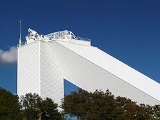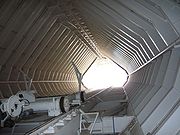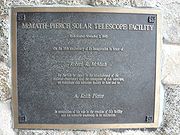
McMath-Pierce Solar Telescope
Encyclopedia
The McMath-Pierce Solar Telescope is a 1.6-m f/
54 reflecting
solar telescope at Kitt Peak National Observatory
in Arizona
, USA. The building was designed by Myron Goldsmith
and built in 1962. It is the largest telescope of its kind in the world and is named for astronomers Robert McMath
and Keith Pierce. At the dedication in 1962, Dr. Waterman read a letter from President Kennedy starting with:
 The telescope contains a heliostat
The telescope contains a heliostat
at the top of its main tower which focuses the sun's light down a long shaft. The distinctive diagonal shaft continues underground, where the telescope's primary mirror
is located. The theoretical resolution of this main telescope 0.07 arcsec, although this is never reached because atmospheric distortions degrade the image quality severely. The image scale is 2.50 arcsec/mm at the image plane.
In addition to this 1.6-meter primary mirror, there are also an East- and West-auxiliary telescope which are completely independent of the main telescope. These two auxiliary telescopes both have a 0.91-meter heliostat which are located beside the main heliostat. These auxiliary telescopes have a slightly shorter focal length and f-numbers of 50 and 44. The resolution of the auxiliary telescopes is 5.11 arcsec/mm and 5.75 arcsec/mm.
 The third mirror of the main telescope which sends the light down into the observing room can be moved above three different positions. Two of these have a vacuum spectrograph
The third mirror of the main telescope which sends the light down into the observing room can be moved above three different positions. Two of these have a vacuum spectrograph
beneath them, one of 18 meter deep and the other 4 meter deep with lower resolution but higher light throughput. These two spectrographs are able to rotate to compensate for the rotation of the image caused by the use of a heliostat. The third position can only be equipped with a static optical table with no image rotation correction and is therefore rarely used.
 The auxiliary telescopes can only be used for imaging on static optical tables and do not provide image rotation correction.
The auxiliary telescopes can only be used for imaging on static optical tables and do not provide image rotation correction.
F-number
In optics, the f-number of an optical system expresses the diameter of the entrance pupil in terms of the focal length of the lens; in simpler terms, the f-number is the focal length divided by the "effective" aperture diameter...
54 reflecting
Reflecting telescope
A reflecting telescope is an optical telescope which uses a single or combination of curved mirrors that reflect light and form an image. The reflecting telescope was invented in the 17th century as an alternative to the refracting telescope which, at that time, was a design that suffered from...
solar telescope at Kitt Peak National Observatory
Kitt Peak National Observatory
The Kitt Peak National Observatory is a United States astronomical observatory located on 2,096 m Kitt Peak of the Quinlan Mountains in the Arizona-Sonoran Desert on the Tohono O'odham Nation, southwest of Tucson...
in Arizona
Arizona
Arizona ; is a state located in the southwestern region of the United States. It is also part of the western United States and the mountain west. The capital and largest city is Phoenix...
, USA. The building was designed by Myron Goldsmith
Myron Goldsmith
Myron Goldsmith was an American architect and designer. He was a student of Mies van der Rohe and Pier Luigi Nervi before designing 40 projects at Skidmore, Owings & Merrill from 1955 to 1983. His last 16 years at the firm he was a general partner in its Chicago office...
and built in 1962. It is the largest telescope of its kind in the world and is named for astronomers Robert McMath
Robert Raynolds McMath
Robert Raynolds McMath was a U.S. solar astronomer.Robert R. McMath was a bridge engineer, businessman, and astronomer. Robert's father, Francis C. McMath, had made a fortune as a bridge builder. They both had a keen interest in amateur astronomy. So in 1922, the McMaths, along with Judge Henry S...
and Keith Pierce. At the dedication in 1962, Dr. Waterman read a letter from President Kennedy starting with:
Construction

Heliostat
A heliostat is a device that includes a mirror, usually a plane mirror, which turns so as to keep reflecting sunlight toward a predetermined target, compensating for the sun's apparent motions in the sky. The target may be a physical object, distant from the heliostat, or a direction in space...
at the top of its main tower which focuses the sun's light down a long shaft. The distinctive diagonal shaft continues underground, where the telescope's primary mirror
Primary mirror
A primary mirror is the principal light-gathering surface of a reflecting telescope.-Description:The primary mirror of a reflecting telescope is a spherical or parabolic shaped disks of polished reflective metal , or in later telescopes, glass or other material coated with a reflective layer...
is located. The theoretical resolution of this main telescope 0.07 arcsec, although this is never reached because atmospheric distortions degrade the image quality severely. The image scale is 2.50 arcsec/mm at the image plane.
In addition to this 1.6-meter primary mirror, there are also an East- and West-auxiliary telescope which are completely independent of the main telescope. These two auxiliary telescopes both have a 0.91-meter heliostat which are located beside the main heliostat. These auxiliary telescopes have a slightly shorter focal length and f-numbers of 50 and 44. The resolution of the auxiliary telescopes is 5.11 arcsec/mm and 5.75 arcsec/mm.
Instruments

Spectrometer
A spectrometer is an instrument used to measure properties of light over a specific portion of the electromagnetic spectrum, typically used in spectroscopic analysis to identify materials. The variable measured is most often the light's intensity but could also, for instance, be the polarization...
beneath them, one of 18 meter deep and the other 4 meter deep with lower resolution but higher light throughput. These two spectrographs are able to rotate to compensate for the rotation of the image caused by the use of a heliostat. The third position can only be equipped with a static optical table with no image rotation correction and is therefore rarely used.

External links
- Kitt Peak virtual tour: McMath-Pierce Solar Telescope
- "McMath Solar Telescope of the Kitt Peak National Observatory", A. K. Pierce, Applied Optics, 3, 1337-1346, 1964.
- A History of the McMath-Pierce Solar Telescope
- Schematic diagram of the McMath-Pierce telescope
- Adaptive optics at the McMath-Pierce telescope

